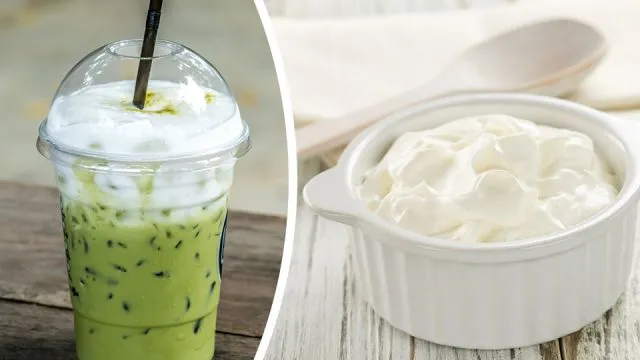
- Share on Facebook5
- Share on Pinterest
- Share on Twitter
Cheese aficionados rejoice! There’s something cheesy brewing on the horizon — cheese tea! Wait… what? Yes, you heard that right. Cheese tea. Not necessarily a combination you’d expect to work. Yet, this cheesy tea fad seems to be making a big splash with tea enthusiasts all over the world. And the long lineups prove it’s worth waiting for. Now it’s coming to the U.S.
What exactly is cheese tea?
Cheese tea — who knew? Coming soon to your local Starbucks… no doubt. But what exactly is it, and is it something you can wrap your head around?
First, what it’s not. It’s not your average tea, made by Lipton, artificially flavored and available at your local grocery store. Cheese tea combines real cheese in teas like matcha, oolong, jasmine and black tea.
But we’re not talking stinky cheese varieties. We’re talking about smooth and creamy cheeses, usually cream cheese, combined with condensed milk. The cheesy brew incorporates fruit teas and green teas at the bottom, with a thick layer of cream cheese on top. Some combos include a cream cheese layer that is slightly sweet, while others include a layer of cream cheese sprinkled with sea salt.
And while it may sound gross, particularly to vegans and the lactose intolerant, it’s actually a bit of a quirky delicacy that’s exploding around the world. The cheese forms a tall, frothy head at the top of the beverage, sort of like whipped cream on a specialty coffee. Customers are encouraged to sip their cheese tea without stirring, reports Star2. So, don’t even think about using a straw. You want to first taste the cheese and then follow it with tea.
Brief history of cheese tea
The cheese tea trend was thought to have started a few years ago, after popular tea shops like Heytea, Royaltea and Regiustea, all of which have China origins, began offering cheese tea. People seemed to love the weird combo. It became an overnight sensation. A “matcha” made in heaven.
In some Asian cities, more than 1,000 cheese teas are sold per outlet. The funny thing is, it wasn’t until recently that people in China began consuming cheese. Today, some tea shops boast queues of 100 people long. In China, for instance, people are lining up for cheese tea for hours at a time, waiting outside tea shops that are serving it up either hot or on ice.
Cheese tea is the next big American sensation
Since its inception in Asia, cheese tea has now found its way to New York and California via the bubble tea chain Happy Lemon, according to The Washington Post. Little Fluffy Head, a Los Angeles shop, also specializes in the tea. And as of this year, a cheese tea shop in Queens, New York — Happy Lemon — also sells a selection of cheese teas, reports Metro.
The original recipe made in Taiwan calls for powdered cheese. But now many tea companies such as the Little Fluffy Head Café in LA opt for real cheese. Here’s how they make their tea.
If you can’t wait for cheese tea to come to your local coffee shop, you can always try making your own version.
Cheese Tea Recipe
Ingredients
- 1 cup organic grass fed whipping cream
- 6 tsp organic grass fed cream cheese, softened
- 10 tsp sweetened condensed milk
- Pinch of Himalayan sea salt
- Tea of your choice (green tea, black tea, matcha, earl grey, oolong or jasmine)
- Sugar (or honey) to taste
Instructions
1. Brew your tea in 1 1/2 cups of hot water.
2. Allow it to chill in the refrigerator.
3. In a large bowl, beat together softened cream cheese and condensed milk.
4. Add whipping cream and continue beating until smooth with a soft peak.
5. Cover with plastic wrap and chill.
6. Pour chilled tea in a tall cup and sweeten with honey or sugar to taste.
7. Scoop out enough cheese to top the tea, about 2 inches.
8. Sprinkle a pinch of sea salt on top of cheese.
Okay, so this may not be a sugar-free treat. But you can certainly replace the sweetened milk and sugar with a good quality raw honey. You may even want to make it your own by using mascarpone cheese and Meyer lemon like a San Francisco shop, reports NBC.
In the end, I guess this isn’t that strange of a concept. Many people enjoy adding milk or cream to their tea, so cheese really isn’t that much of a stretch. Here’s to your cheesy mustache!
— Katherine Marko
- Share on Facebook5
- Share on Pinterest
- Share on Twitter

